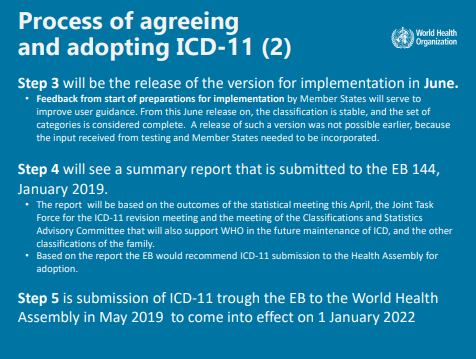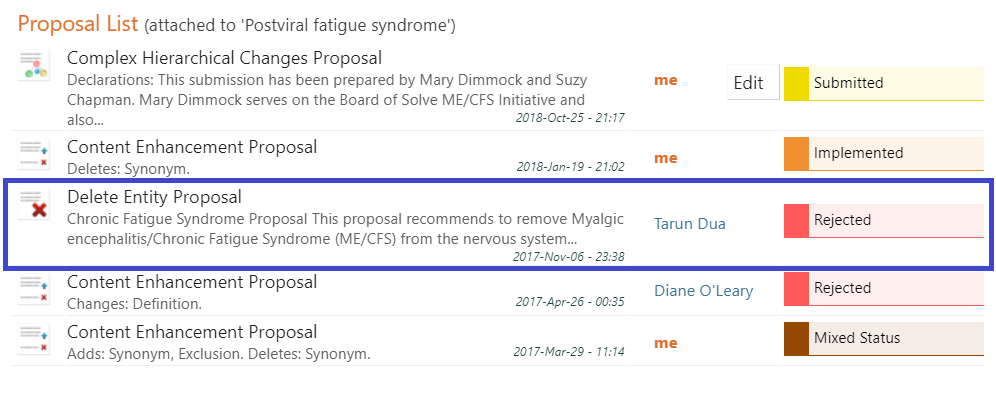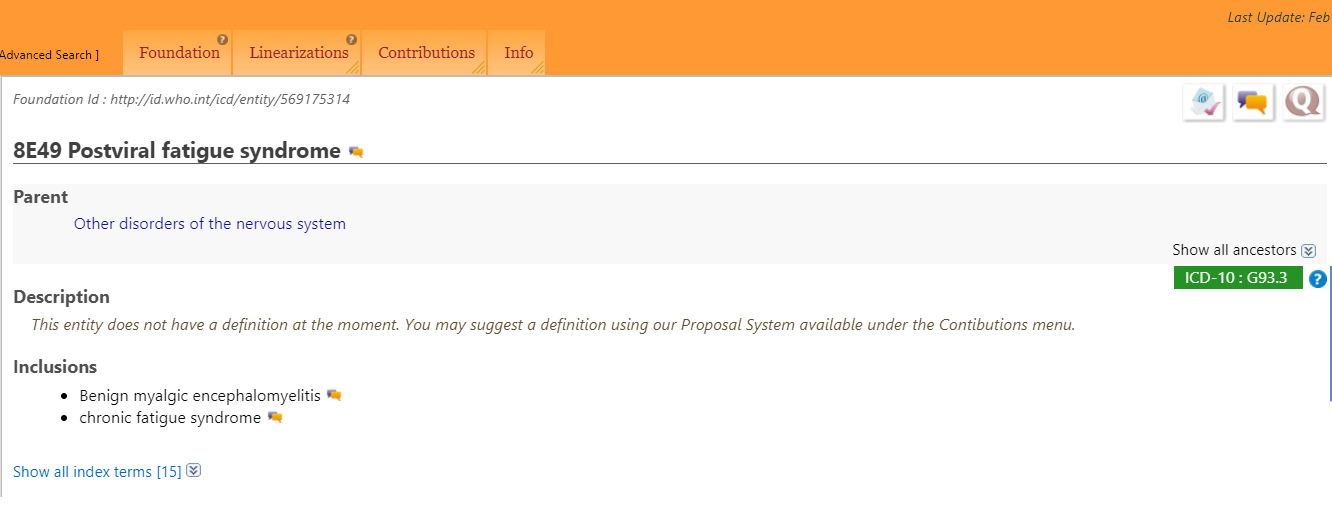As some of you will be aware, there are no disorder/disease descriptions or diagnostic guidelines for any chapters of ICD-10 other than for Chapter V
Mental and Behavioural Disorders.
ICD-10 Volume 1 includes only brief descriptions for the mental and behavioural disorder categories in Chapter V.
Two companion publications were developed for use with ICD-10 which expand on Chapter V disorder descriptions and also provide diagnostic guidelines. These companion publications are available as license free downloads:
The ICD-10 Classification of Mental and Behavioural Disorders Clinical descriptions and diagnostic guidelines (aka "The Blue Book"):
https://www.who.int/classifications/icd/en/bluebook.pdf
intended for mental health professionals for general clinical, educational and service use.
For ICD-11, the
WHO Department of Mental Health and Substance Abuse has developed an equivalent publication - the
"Clinical Descriptions and Diagnostic Guidelines (CDDG) for ICD‐11 Mental, Behavioural and Neurodevelopmental Disorders."
ICD-11 is scheduled for presentation to the World Health Assembly (WHA) in May, this year.
But WHA's endorsement of ICD-11 (assuming it does receive approval in May) will not come into effect until
January 01, 2022. After this date, WHO member states can start using ICD-11 for reporting health statistics when their health systems have transitioned from ICD-10 to the new edition.
Although WHO will be encouraging member states to start preparations for migration, there is no mandatory implementation date and member states will migrate to ICD-11 at their own pace. Global adoption will likely be a patchy and prolonged process and for a period of time, WHO will be accepting data reported using
both ICD-10 and the new ICD-11 code sets.
No countries have yet announced tentative implementation schedules.
NHS Digital says:
"No decision has been made for the implementation of ICD-11 in England, however NHS Digital plan to undertake further testing of the latest release and supporting products that will inform a future decision."
Until the UK has implemented ICD-11, the mandatory classification system and mandatory terminology system for use in the NHS is ICD-10 (Version: 2015) and SNOMED CT UK Edition (mandatory adoption in primary care from April 2018; mandatory adoption across all NHS secondary care by 2020).
The development process for the ICD‐11 CDDG has been undertaken via the
Global Clinical Practice Network:
https://gcp.network/en/about
ICD-11 Guidelines:
https://gcp.network/en/icd-11-guidelines
Practitioners and institutions who signed up to participate in the CDDG's development have been able to review and input into the draft texts. But no draft of the texts has been made available for stakeholder scrutiny and comment. So, for example, I have not had access to the full draft text for the Clinical descriptions and diagnostic guidelines for ICD-11's "Bodily distress disorder (BDD)" during any stage of the drafting process.
The CDDG guidelines include the "Essential (Required) Features, Boundaries with Other Disorders and Normality, Additional Features sections, Culture-Related Features."
Disorder descriptions for ICD-11 are less rigid than the criteria sets in DSM-5 and allow practitioners more flexibility to use clinical discretion when making diagnoses.
Note that the
Clinical Descriptions and Diagnostic Guidelines (CDDG) for ICD‐11 Mental, Behavioural and Neurodevelopmental Disorders should not be confused with the
ICD-11 Primary Health Care (PHC) Guidelines for Diagnosis and Management of Mental Disorders (ICD-11 PHC), for which no timeline for finalization and release has been published by WHO. The ICD-11 PHC is a revision of the ICD-10 PHC (1996). Intended as a non WHO mandatory manual, the revised publication is proposed to comprise 27 mental disorder categories.
This paper in the February 2019 edition of World Psychiatry describes major changes to the structure of the ICD‐11 classification of mental disorders as compared to the ICD‐10; discusses new categories that have been added for ICD‐11 and presents rationales for their inclusion; and describes important changes that have been made in each ICD‐11 disorder grouping.
What the paper does not give is a firm release date for the CDDG - stating only that
"WHO will publish the CDDG as soon as possible following approval of the overall system by the WHA."
Reed GM, First MB, Kogan CS, et al. Innovations and changes in the ICD-11 classification of mental, behavioural and neurodevelopmental disorders. World Psychiatry. 2019;18(1):3-19. Reed GM, First MB, Kogan CS, et al.
HTML: https://www.ncbi.nlm.nih.gov/pmc/articles/PMC6313247/
PDF: https://www.ncbi.nlm.nih.gov/pmc/articles/PMC6313247/pdf/WPS-18-3.pdf
(...)
Disorders of bodily distress and bodily experience
ICD‐11 disorders of bodily distress and bodily experience encompass two disorders: bodily distress disorder and body integrity dysphoria. ICD‐11 bodily distress disorder replaces ICD‐10 somatoform disorders and also includes the concept of ICD‐10 neurasthenia. ICD‐10 hypochondriasis is not included and instead is reassigned to the OCRD [Ed:Obsessive‐compulsive and related disorders] grouping.
Bodily distress disorder * is characterized by the presence of bodily symptoms that are distressing to the individual and an excessive attention directed toward the symptoms, which may be manifest by repeated contact with health care providers
69. The disorder is conceptualized as existing on a continuum of severity and can be qualified accordingly (
mild,
moderate or
severe) depending on the impact on functioning. Importantly, bodily distress disorder is defined according to the presence of essential features, such as distress and excessive thoughts and behaviours, rather than on the basis of absent medical explanations for bothersome symptoms, as in ICD‐10 somatoform disorders.
*I have embedded links to the
ICD-11 Orange Maintenance Platform disorder descriptions (these are not included in the paper).
Note that DSM-5's
Somatic symptom disorder is included under
Synonyms to ICD-11's Bodily distress disorder.
Note also that Mary Dimmock and I are still waiting for our proposals for addition of exclusions for (B)ME and CFS under Bodily distress disorder to be processed.
SNOMED CT
The
SNOMED CT Concept term SCTID: 723916001: Bodily distress disorder was added to the July 2017 release of SNOMED CT International Edition.
SNOMED International's classification leads confirmed that the term was added by the team working on the SNOMED CT and ICD-11 MMS Mapping Project as "an exact match for the ICD-11 term, Bodily distress disorder."
In ICD-11, Bodily distress disorder has three severity specifiers: Mild BDD; Moderate BDD; and Severe BDD, which are each assigned a unique code and a unique description/characterization text. It was submitted that including the three ICD-11 BDD severities might help clinicians and coders to distinguish between the SNOMED CT/ICD-11 Bodily distress disorder concept term and the similarly named, but differently conceptualized,
Bodily distress syndrome (Fink et al. 2010), which has two severities. A request for addition of the three BDD severities was submitted and approved in early 2018 and the specifiers (Mild BDD; Moderate BDD; and Severe BDD) were added as Children under BDD for the July 2018 release of the International Edition.
When the WHO has released the CDDG, I will update this thread.
-------------------------------------
Resources:
Comparison of Classification and Terminology Systems, Version 3, Dimmock & Chapman, July 2018
Comparison of SSD, BDD, BDS, BSS in classification systems, Version 1, Dimmock & Chapman, July 2018
Proposal: Revision of G93.3 legacy terms for ICD-11, Dimmock & Chapman, March 2017





